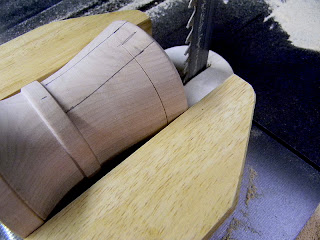This is a nutcracker I made for my wife a few years ago. It was a fun project, and my intention was to build one each year. That was 2007, and now four years later I'm finally getting around to building another nutcracker. Best intentions and all that, but at any rate, this chaps name is Otto Von Bismarck.
I really did like the project, but I have to admit that painting was a pain, but at the same time if there is any magic (and I do hope there is a little) it's when they are painted. They really do come to life, pun intended. The fur by the way is rabbit, and it's worth getting the real thing.
The directions can be found in Fine Woodworking's book
Lathe and Turning Techniques. The process is pretty straightforward, but little differences can add up to a nutcracker with a personality all his own.
First thing is to glue up a blank and turn the main body and hat, called a shako. I remembered after it was done that I should have used spruce as the face is unpainted and the color of spruce is about right for skin. I used red birch here and well he'll just look like he had some brandy while standing guard in the cold.
If you look closely, you can see the small brim left on the hat. I later thought that it made it look too much like a top hat and not a military shako, so I turned it off. It's little decisions like this that add personality to a pretty standard item.
Here I turn the arms, two at a time. Below I'm sizing with a wrench. I pretty much eye-ball the sizes, but the wrench gives a jumping off point.
Above are the legs, body and arms.
Clamping up the arm at a 45º angle can be tricky, but tape helps a bunch. Just lay the points so they touch, put in some glue, and close the piece. A spring clamp holds it tight for overnight. Later I'll pin it with a dowel.
A screw clamp helps steady the body for the slot that has to be sawn next. Two cuts on the big bandsaw, and then I clean it up on the small one. The big one has a 3/4" blade and does only straight cuts, and the small one has a 3/16" blade for curves and such. This really does speed things up.
Making the cut
Above you can see another example of personality. I cut the hat off and then cut the "head" at an angle so the hat leans back a little, which gives the finished nutcracker a more relaxed pose.
Next saw and chisel the angled slot that allows the crank to rest against the body. Otherwise it would stick out.
Drilling the 3/16" hole for the crank handle. An Allen wrench helps as it has a handle. Be sure to leave the crank big, then fit it and trace the actual body shape and then sand to the line.
Mount the hands on some 1/4" dowels and leave them plenty long to give you a handle to carve with.
Here's a look at the crank. I enlarged the plans 150% and it was spot on. Notice how I left the pattern uncut at the top left...this is the part that is trimmed after pinning.
And here he is, almost done. One thing I do is all the joints are drilled with 1/4" holes and then joined with dowels. Just use those dowel markers after drilling one hole. On the first one I didn't do this on all the joints, and this made assembly a lot harder, plus a couple joint came loose. Live and learn.
The nose always takes the longest it seems. I started with a big nose, but it just didn't seem right, so I carved this long narrow beak and I think it looks great. I'm gonna paint him mostly white, and have a velvet cape made trimmed in white fur. All the separate things like belt buckles and buttons are painted separately and glued on, which is tedious but does look better. One thing I noticed is is sword is too short, but that's not glued yet. Really just gotta keep looking at him and you will see what has to be changed.
I think he looks good so far. I will post pictures, and his name on Christmas. I like the sword hilt, and the tipped back hat, and the nose. Can't wait to see him painted.
I should say here that he is not for my wife, but rather he is for my daughter Erinn. She is going to see the play in Bangor next weekend, a girls weekend away, so the memory will be fresh in her mind...she is
my Clara.

















































